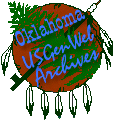History of Canadian County
Source: Jean Kyle
Sand Hills -- site of the last great Indian fight in Oklahoma, fought by a company of soldiers in 1875 while guarding the Cheyenne and Arapaho agency at Darlington from an Indian outbreak. Located about a mile northwest of Darlington.
General Sheridan's Headquarters -- at Fort Reno, where he was stationed late in the 1870's during the time he was engaged in helping round up the renegade Indians. Moved to Adams Park on the outskirts of El Reno.
Darlington -- named for Brinton Darlington who was sent to the site in 1869 to establish an agency for the Cheyenne and Arapahos. A Quaker, he was much loved by the Indians but was unequal in physical strength for the strenuous task and died in 1872. His body lies in the Indian cemetery one mile south of Concho.
Cheyenne Transporter -- First newspaper published in western Oklahoma launched by Lafe Merritt at Darlington in 1879 for the population at the Indian agency and for cattlemen who leased Indian lands for their cattle herds in this area. The paper lasted for six years. It carried the brands of all of the cattlemen in this section.
Caddo Springs -- presently known as Concho (named for Agent Shell), was named for the famed springs located on the old Stage Trail from Caldwell, Kans., through Darlington and Fort Reno to Fort Sill. This was a favorite camping place for both Indians and freighters in the early days due to abundance of the sparkling cold water. The Cheyenne school was first built here in 1879 and in the 1880's the agency was moved from Darlington to this location and the name changed from Caddo Springs to Concho.
Mennonite Mission -- built in the early 1890's by the Mennonite church just east of Darlington.
Fort Reno -- established in February, 1876 to house the troops which were frequently sent to Darlington to protect the officials of the Indian agency and the friendly Indians. The garrison provided police protection for the old Oklahoma area before and during the opening of 1889. Became a regimental headquarters during Spanish-American war. Changed to remount station in 1908 to provide mounts for army. In World War II added training of pack outfits and sent thousands of mules and their drivers to India. Following the war trained and furnished thousands of mounts and mules for Greece and Turkey. In 1949 the military activities were abandoned and the property was turned to the Department of Agriculture.
Chisholm Trail -- The great route for running the huge cattle heads from Texas to the nearest railroads in Kansas to be transported to the meat hungry eastern markets. Crossed South Canadian a few miles west of Mustang, veered northeast to west edge of present Yukon, then across North Canadian and northwest to vicinity of Okarche. An estimated two million cattle were driven over this route before the first railroad penetrated the Indian country into Texas.
Ghost towns -- Frisco City and Reno City were the outstanding municipalities platted during the opening as both had aspirations for the county seat. Frisco City, located three miles northwest of Yukon, settled by Union veterans, faded away when the Choctaw railway built on the south side of the North Canadian river. Was an active candidate for the county seat, but El Reno won the election by devious means. Reno City, located three miles north of El Reno, also died when the Rock Island railway built a mile west instead of passing through it.
Land Drawing of 1901 -- Conducted at the present day site of Irving School in El Reno when the Kiowa-Comanche lands were distributed by lottery with 30,000 people looking on.
 Welcome to OKGenWeb's
Welcome to OKGenWeb's









